Just Earth News | @justearthnews | 19 Sep 2023, 06:51 am Print
 Children
Children Image: UNICEF/Georges Harry Rouzier
The number of children missing out on any schooling has increased by six million, bringing the total to 250 million, according to new figures released on Monday by the UN Education, Science, and Cultural Organization (UNESCO).
The increase is partly due to the mass exclusion of women and girls from education in Afghanistan but can also be attributed to broader stagnation in education provision worldwide.
The findings undermine UN Sustainable Development Goal 4, which sets the goal of quality education for all by 2030.
Way off track
If countries were on track with their national SDG 4 targets, six million more children would be in pre-school, 58 million more children and adolescents would be in school, and at least 1.7 million more primary school teachers would have been trained, according to the report.
“Education is in a state of emergency,” said UNESCO Director-General Audrey Azoulay.
“While considerable efforts were made over the past decades to ensure quality education for all, UNESCO data demonstrates that the number of children out of school is now rising.
“States must urgently remobilize if they do not want to sell out the future of millions of children.”
Future ‘in your hands’
One year ago, 141 countries committed at the UN Transforming Education Summit to accelerate progress towards SDG 4.
Four out of five countries aimed to advance teacher training and professional development, seven out of 10 committed to increasing or improving their investment in education, and one in four committed to increase financial support and school meal provision.
For countries to achieve their SDG 4 targets, however, millions more children must be enrolled in early childhood education every year until 2030, and the progress in primary completion rates needs to almost triple.
“These commitments must now be reflected in acts. There is no more time to lose. To achieve SDG 4, a new child needs to be enrolled in school every 2 seconds between now and 2030,” said the Director-General.
“The future of millions of children is in your hands”, she emphasised to Member States.
Insufficient growth
The report highlights that, since 2015, the number of children completing primary education has increased by less than three percentage points to 87 per cent.
The number completing secondary education, meanwhile, has increased by less than five per cent to just 58 per cent.
In the 31 low and lower-middle-income countries that measure learning progress at the end of primary school, Viet Nam is the only country where the majority of its children are achieving minimum proficiency in both reading and mathematics.
Global framework
The Education 2030 Framework for Action calls on countries to set intermediate benchmarks for SDG 4 indicators. In an inclusive approach, countries were assisted in setting benchmarks to achieve by 2025 and 2030 for seven SDG 4 benchmarks on pre-primary education, school attendance, completion and learning, gender equity, learning proficiency, trained teachers, and public expenditure.
- New form of 'religious fascism': Bangladesh students, cultural activists protest arrest of Baul singer for hurting religious sentiments
- NY Mayor-elect Mamdani backs Starbucks strike: 'No Contract, No Coffee'
- Unprecedented housing emergency hits Ukraine — Millions struggle for shelter amid ongoing conflict against Russia
- Israel-Hamas crisis: Nearly every child is showing signs of trauma after years of conflict in Gaza, shows report
- Baloch Martyrs’ Day in Berlin: Activists slam Pakistan, demand ‘Free Balochistan’



-1763561110.jpg)


